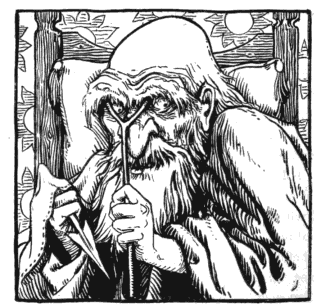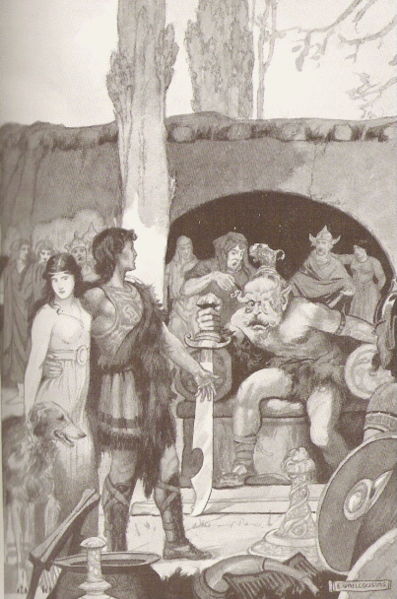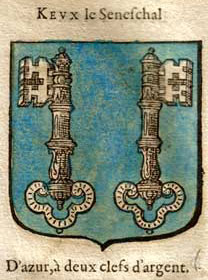|
Ysbaddaden
; "Ysbaddaden, Chief of Giants," is the primary antagonist of the Welsh romance ''Culhwch ac Olwen''.Helmut Birkhan: Kelten. Versuch einer Gesamtdarstellung ihrer Kultur. Verlag der Österreichischen Akademie der Wissenschaften, Wien 1997, , S. 473. A vicious giant residing in a nigh unreachable castle, he is the father of Olwen and uncle of Goreu fab Custennin. Culhwch's father, King Cilydd son of Celyddon, loses his wife Goleuddydd after a difficult childbirth. When Cilydd remarries, the young Culhwch rejects his stepmother's attempt to pair him with his new stepsister. Offended, the new queen puts a curse on him so that he can marry no one besides the beautiful Olwen, daughter of the giant Ysbaddaden. Though he has never seen her, Culhwch becomes infatuated with her, but his father warns him that he will never find her without the aid of his famous cousin Arthur. The young man immediately sets off to seek his kinsman. He finds him at his court in Celliwig in Cornwall and asks ... [...More Info...] [...Related Items...] OR: [Wikipedia] [Google] [Baidu] |
Culhwch
Culhwch (, with the final consonant sounding like Scottish "loch"), in Welsh mythology, is the son of Cilydd son of Celyddon and Goleuddydd, a cousin of Arthur and the protagonist of the story ''Culhwch and Olwen'' (the earliest of the medieval Welsh tales appended to Lady Charlotte Guest's edition of the Mabinogion). In this tale the etymology of ''Culhwch'' is explained as "sow run" (''cul'' "narrow, a narrow thing"; ''hwch'' "sow, pig"), but this is likely to be folk etymology. According to the narrative, Culhwch is born to his maddened mother Goleuddydd after she is frightened by a herd of swine. The swineherd finds Culhwch in the pigs' run, and takes him back to his father Cilydd. Culhwch is described as being "of gentle lineage". In ''Culhwch and Olwen'' Culhwch's father, King Cilydd son of Celyddon, loses his wife Goleuddydd after a difficult childbirth. When he remarries, the young Culhwch rejects his stepmother's attempt to pair him with his new stepsister. Offended, t ... [...More Info...] [...Related Items...] OR: [Wikipedia] [Google] [Baidu] |
Mabon Ap Modron
Mabon ap Modron is a prominent figure from Welsh literature and mythology, the son of Modron and a member of Arthur's war band. Both he and his mother were likely deities in origin, descending from a divine mother–son pair. He is often equated with the Demetian hero Pryderi fab Pwyll, and may be associated with the minor Arthurian character Mabon ab Mellt. Etymology His name is related to the Romano-British god Maponos, whose name means "Great Son"; Modron, in turn, is likely related to the Gaulish goddess Dea Matrona. The name ''Mabon'' is derived from the Common Brittonic and Gaulish deity name ''Maponos'' "Great Son", from the Proto-Celtic root ''*makwo-'' "son". Similarly, Modron is derived from the name of the Brittonic and Gaulish deity ''Mātronā'', meaning "Great Mother", from Proto-Celtic ''*mātīr'' "mother". Role in Welsh tradition ''Culhwch ac Olwen'' Culhwch's father, King Cilydd, the son of Celyddon, loses his wife Goleuddydd after a difficult childbir ... [...More Info...] [...Related Items...] OR: [Wikipedia] [Google] [Baidu] |
Culhwch And Olwen
''Culhwch and Olwen'' ( cy, Culhwch ac Olwen) is a Welsh tale that survives in only two manuscripts about a hero connected with Arthur and his warriors: a complete version in the Red Book of Hergest, c. 1400, and a fragmented version in the White Book of Rhydderch, c. 1325. It is the longest of the surviving Welsh prose tales. Overview Dating The prevailing view among scholars was that the present version of the text was composed by the 11th century, making it perhaps the earliest Arthurian tale and one of Wales' earliest extant prose texts,The Romance of Arthur: An Anthology of Medieval Texts in Translation, ed. James J. Wilhelm. 1994. 25. but a 2005 reassessment by linguist Simon Rodway dates it to the latter half of the 12th century. The title is a later invention and does not occur in early manuscripts. Editions Lady Charlotte Guest included this tale among those she collected under the title ''The Mabinogion''. Synopsis Culhwch's father, King Cilydd son of Celyddon, ... [...More Info...] [...Related Items...] OR: [Wikipedia] [Google] [Baidu] |
Cilydd
''Culhwch and Olwen'' ( cy, Culhwch ac Olwen) is a Welsh tale that survives in only two manuscripts about a hero connected with Arthur and his warriors: a complete version in the Red Book of Hergest, c. 1400, and a fragmented version in the White Book of Rhydderch, c. 1325. It is the longest of the surviving Welsh prose tales. Overview Dating The prevailing view among scholars was that the present version of the text was composed by the 11th century, making it perhaps the earliest Arthurian tale and one of Wales' earliest extant prose texts,The Romance of Arthur: An Anthology of Medieval Texts in Translation, ed. James J. Wilhelm. 1994. 25. but a 2005 reassessment by linguist Simon Rodway dates it to the latter half of the 12th century. The title is a later invention and does not occur in early manuscripts. Editions Lady Charlotte Guest included this tale among those she collected under the title ''The Mabinogion''. Synopsis Culhwch's father, King Cilydd son of Celyddon, ... [...More Info...] [...Related Items...] OR: [Wikipedia] [Google] [Baidu] |
Sir Kay
In Arthurian legend, Sir Kay ( cy, Cai, Middle Welsh ''Kei'' or ''Cei''; la, Caius; French: ''Keu''; Old French: ''Kès'' or ''Kex'') is King Arthur's foster brother and later seneschal, as well as one of the first Knights of the Round Table. In later literature he is known for his acid tongue and bullying, boorish behaviour, but in earlier accounts he was one of Arthur's premier warriors. Along with Bedivere, with whom he is frequently associated, Kay is one of the earliest characters associated with Arthur. Kay's father is called Ector in later literature, but the Welsh accounts name him as Cynyr Ceinfarfog. Cai in Welsh tradition Cai or Cei is one of the earliest characters to be associated with the Arthurian mythology, appearing in a number of early Welsh texts, including ''Culhwch ac Olwen'', '' Geraint fab Erbin'', '' Iarlles y Ffynnon'', ''Peredur fab Efrawg'', ''Breuddwyd Rhonabwy'', ''Pa Gur'', and the Welsh Triads. His father is given as Cynyr Ceinfarfog (Fork-Beard ... [...More Info...] [...Related Items...] OR: [Wikipedia] [Google] [Baidu] |
Twrch Trwyth
Twrch Trwyth (; also Trwyd, Troynt (MSS.''HK''); Troit (MSS.''C1 D G Q''); or Terit (MSS. ''C2 L'')) is an enchanted wild boar in the ''Matter of Britain'' great story cycle that King Arthur or his men pursued with the aid of Arthur's dog Cavall ( cy, Cafall, la, Cabal). The names of the hound and boar are glimpsed in a piece of geographical onomasticon composed in Latin in the ninth century, the ''Historia Brittonum''. However, a richly elaborate account of the great hunt appears in the Welsh prose romance ''Culhwch and Olwen'', probably written around 1100. A passing reference to Twrch Trwyth also occurs in the elegy ''Gwarchan Cynfelyn'' preserved in the Book of Aneirin. The name in Welsh can be construed to mean "the boar Trwyth", and may have its analogue in the boar Triath of Irish mythology (see #Etymology and Irish cognate below). ''Historia Brittonum'' The earliest reference to the boar Trwyth occurs in the tract ''De Mirabilibus Britanniae'' (or ''Mirabilia'' in sho ... [...More Info...] [...Related Items...] OR: [Wikipedia] [Google] [Baidu] |
Giants (Welsh Folklore)
Giants ( cy, cewri, italic=no) feature prominently in Welsh folklore and mythology. Among the most notable are Bendigeidfran fab Llyr, a mythological king of Britain during the Second Branch of the Mabinogi, Idris Gawr of Cader Idris, and Ysbaddaden Bencawr, the chief antagonist of the early Arthurian tale '' How Culhwch won Olwen''. Both Arthur and Gwalchmai fab Gwyar feature prominently as giant-slayers in Welsh tradition.The Giants of Wales and their dwellings/ref> Giants are also described by Geoffrey of Monmouth as the original inhabitants of Britain, who were overwhelmed by human settlers.https://www.yorku.ca/inpar/geoffrey_thompson.pdf Tales Giants in the Mabinogion In the Second Branch of the Mabinogi, Branwen ferch Llyr, Britain is ruled by the giant Bran the Blessed, who has never been able to fit inside any dwelling. Also in the Second Branch, the Pair Dadeni (Cauldron of Rebirth) is brought to Wales from Ireland by the giant Llassar Llaes Gyfnewid and his wife, ... [...More Info...] [...Related Items...] OR: [Wikipedia] [Google] [Baidu] |
Bedivere
Bedivere ( or ; cy, Bedwyr; la, Beduerus; french: link=no, Bédoier, also Bedevere and other spellings) is one of the earliest characters to be featured in the legend of King Arthur, originally described in several Welsh texts as the one-handed great warrior named Bedwyr Bedrydant. Arthurian chivalric romances, inspired by his portrayal in the chronicle ''Historia Regum Britanniae'', portray Bedivere as a Knight of the Round Table of King Arthur who serves as Arthur's marshal and is frequently associated with his brother Lucan and his cousin Griflet as well as with Kay. In the English versions, Bedivere notably assumes Griflet's hitherto traditional role from French romances as the one who eventually returns Excalibur to the Lady of the Lake after Arthur's last battle. Bedwyr In early Welsh sources, Bedwyr Bedrydant ("Bedwyr of the Perfect Sinew") is a handsome, one-handed warrior under Arthur's command. His father is given as Pedrawd or Bedrawd, and his children as Am ... [...More Info...] [...Related Items...] OR: [Wikipedia] [Google] [Baidu] |
Goreu Fab Custennin
Goreu fab Custennin (also spelled as Gorau) is a hero of Welsh and early Arthurian mythology, the son of Custennin, and cousin to Arthur, Culhwch and Saint Illtud through their grandfather Amlawdd Wledig. He is a significant character in the Middle Welsh Arthurian tale ''Culhwch and Olwen'', and also appears in a number of other medieval texts. His name may be derived from ; "of Cornwall."Bromwich, Rachel. ''Trioedd Ynys Prydein.'' Role in Welsh tradition How Culhwch won Olwen While on the quest to locate the stronghold of Ysbaddaden Bencawr, Culhwch ap Cilydd and his six companions come across a shepherd and his flock. They learn that he is Ysbaddaden's brother, and that the giant has murdered twenty-three of his twenty four children. In a bid to save their youngest son from suffering the same fate, the shepherd and his wife hide him away in a chest. Cai, one of Arthur's foremost knights, offers to take the boy with him on the quest for Olwen, promising to fight to the deat ... [...More Info...] [...Related Items...] OR: [Wikipedia] [Google] [Baidu] |
Arthurian Characters
The Arthurian legend features many characters, including the Knights of the Round Table and members of King Arthur's family. Their names often differ from version to version and from language to language. The following is a list of characters with descriptions. : Indicates a Knight of the Round Table. See also * List of characters named Ywain in Arthurian legend The following is a list of characters are named Yvain (or a variation of Yvain), mentioned in Arthurian legend. The work(s)in which they appear are italicized.Brugger, Ernst. ''Yvain and His Lion''. Modern Philology. 1941 *Yvain li filz au roi Ur ... References {{Arthurian Legend Arthurian, Arthurian characters ... [...More Info...] [...Related Items...] OR: [Wikipedia] [Google] [Baidu] |
Welsh Mythology
Welsh mythology (Welsh: ''Mytholeg Cymru'') consists of both folk traditions developed in Wales, and traditions developed by the Celtic Britons elsewhere before the end of the first millennium. As in most of the predominantly oral societies Celtic mythology and history were recorded orally by specialists such as druids ( cy, derwyddon). This oral record has been lost or altered as a result of outside contact and invasion over the years. Much of this altered mythology and history is preserved in medieval Welsh manuscripts, which include the Red Book of Hergest, the White Book of Rhydderch, the Book of Aneirin and the Book of Taliesin. Other works connected to Welsh mythology include the ninth-century Latin historical compilation ''Historia Brittonum'' ("History of the Britons") and Geoffrey of Monmouth's twelfth-century Latin chronicle ''Historia Regum Britanniae'' ("History of the Kings of Britain"), as well as later folklore, such as the materials collected in ''The Welsh Fa ... [...More Info...] [...Related Items...] OR: [Wikipedia] [Google] [Baidu] |
Menw
Menw, son of Three-Cries ( wlm, Menw fab Teirgwaedd), is a hero and shapeshifter in early Welsh literature, an "Enchanted Knight" of King Arthur at his court at Celliwig. He appears most prominently in the early Arthurian tale ''Culhwch and Olwen'', in which he is handpicked among Arthur's warriors to accompany Culhwch on his quest to win Olwen. An "Enchanter Knight" of Arthur's court, he learned one of the Three Enchantments from Uther Pendragon. He is ascribed a son named Anynnawg. Role in Welsh tradition After being cursed by his stepmother so that he marry no one but Olwen, daughter of the giant Ysbaddaden, Culhwch ap Cilydd seeks assistance from his cousin Arthur to win her hand in marriage. Arthur agrees to help him, sending six of his many warriors to assist him on his quest, with Menw as the sixth. Each warrior has his own unique skill; Menw is a skilled magician, able to place he and his companions under an illusion of invisibility so as to protect them in savage lands. P ... [...More Info...] [...Related Items...] OR: [Wikipedia] [Google] [Baidu] |





